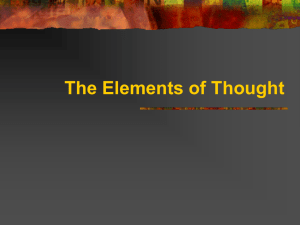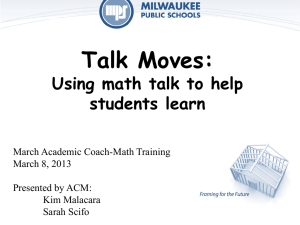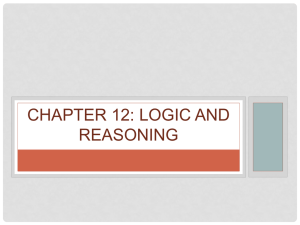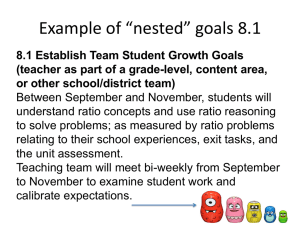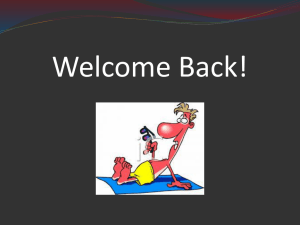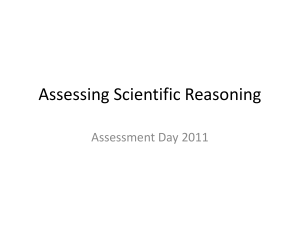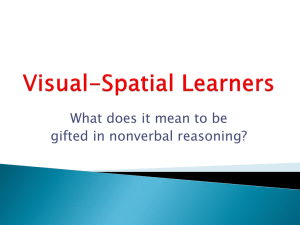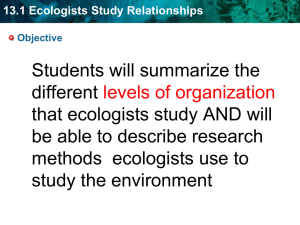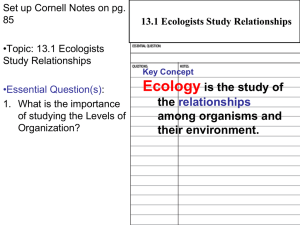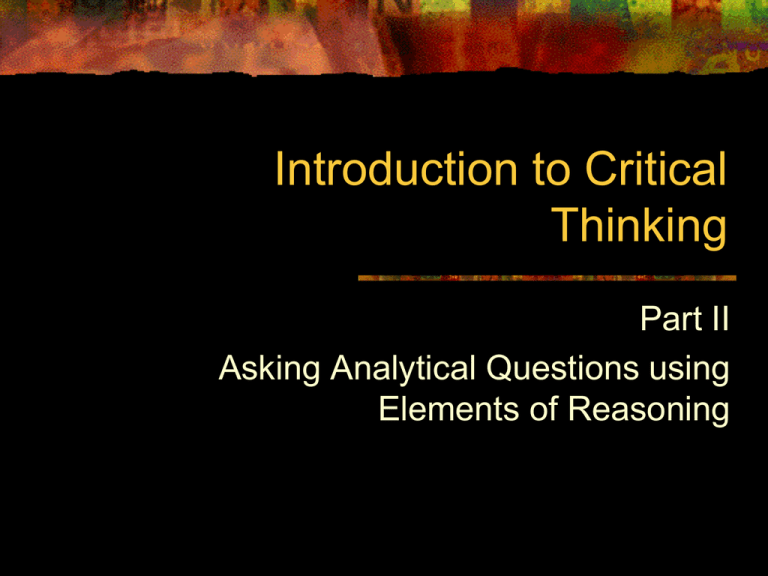
Introduction to Critical
Thinking
Part II
Asking Analytical Questions using
Elements of Reasoning
3 Key Questions
Why do we need critical thinking?
What is critical thinking?
What do we do to think critically?
The Three Dimensions
of Critical Thinking
Critical
Thinking
Analysis
of thinking
by focusing on
the parts
Evaluation
of thinking
by focusing on
the standards
Improvement
of thinking
by using what
you learned
Elements of Reasoning
Traits of
the
Disciplined
Mind
Reasoning: three
aspects
Reasoning
The process of
drawing conclusions or
figuring something out
Standards
for
Reasoning
The quality of our thinking is
largely reflected in the quality of
our questions.
Circle –
Dots
Critical thinking is the way you do
everything you do
LOGIC
OF
Student
Thinking
Instruction
Content
StandardsElementsTraits
What is involved in analyzing reasoning?
(Story, argument, point of view, subject)
In other words, what elements must you
account for in order for the analysis to be
substantive?
Analyzing a Cartoon
Look at the cartoon and analyze it by
asking questions.
1. Individually, write a series of questions
that attempt to probe the meaning of the
cartoon.
2. With a group, compare your questions
with others. Add to your list.
Whenever we think
in attempting We think
to answer a for a
question. purpose
based on
concepts and
theories
to make
inferences and
judgments
We use
data, facts,
and
experiences
within a
point of view
based on
assumptions
leading to
implications
and conse quences.
A CRITICAL THINKER
Considers the
Elements of Thought
Points of View
Frame of Reference
Perspective
Orientation
Implications &
Consequences
Assumptions
Presuppositions,
taking for granted
Goal, objective
Elements
of
Thought
Concepts
Theories, laws,
models, definitions, principles
Elements wheel
Purpose of the
Thinking
Questions at
Issue
Problem
Information
Data, observations,
facts, experiences
Interpretation
& Inference
Conclusions,
solutions
Eight Questions Students Can Routinely
Ask When They Understand
the Elements of Reasoning
1.
What is the main purpose of the reasoning?
2.
What are the key issues, problems, and questions
being addressed?
3.
What is the most important information being used?
4.
What main inferences are embedded in the
reasoning?
5.
What are the key concepts guiding the reasoning?
6.
What assumptions are being used?
7.
What are the positive and negative implications?
8.
What point of view is/should be represented?
Logic of a Cartoon
Now use the elements of reasoning to
generate more questions for the same
cartoon.
ALSO,
Examine your original questions and
identify which elements they target.
Key Points
Individually we can ask a limited number
of questions
Collectively we can ask even more
However, when equipped with a
framework, individually and collectively we
can ask even more
We must
routinely
Take our
thinking
We must routinely take our thinking apart
apart
Eight Questions Students Can Ask to
Figure out the Logic of a Subject or
Discipline:
1.
What is the main purpose of the subject?
2.
What are the key issues, problems, and questions
addressed within the subject?
3.
What kinds of information are pursued within the
discipline?
4.
What types of inferences or judgments are made?
5.
What key concepts inform the discipline?
6.
What key assumptions underlie the discipline?
7.
What are some important implications of studying the
discipline?
8.
What points of view are fostered within the discipline?
Eight Questions Students Can Ask to Figure out
the Logic of a Character in a Story
1.
What is the main purpose of the character?
2.
What are the key issues and problems facing the character?
3.
What is the most significant information the character uses in
his or her reasoning?
4.
What main inferences or judgments are made by the
character?
5.
What key concepts guide the character’s reasoning?
6.
What main assumptions guide the behavior of the character?
7.
8.
What are the most important implications of the character’s
thinking and behavior?
What is the main point of view of the character? Does that
point of view change during the story? If so, how?
Questions Targeting the Elements of Thought
in a writing a paper
Purpose: What am I trying to accomplish? What is my central aim or
goal?
Information: What information am I using in coming to that conclusion?
What experience have I had to support this claim? What
information do I need to settle the question?
Inferences/Conclusions: How did I reach this conclusion? Is there
another way to interpret the information?
Concepts: What is the main idea here? Could I explain this idea?
Assumptions: What am I taking for granted? What assumption has led
me to that conclusion?
Implications/Consequences: If someone accepted my position, what
would implications? What am I implying?
Points of View: From what point of view am I looking at this issue? Is
there another point of view I should consider?
Questions: What question am I raising? What question am I
addressing?
The Logic of an Experiment
(Attach a detailed description of the experiment or
laboratory procedure.)
The main goal of the experiment is…
The hypothesis(es) we seek to test in this experiment
is(are)…
The key question the experiment seeks to answer is…
The controls involved in this experiment are…
The key concept(s) or theory(ies) behind the experiment
is(are)…
The experiment is based on the following assumptions…
The data that will be collected in the experiment are…
The potential implications of the experiment are…
The point of view behind the experiment is…
A CRITICAL THINKER
Considers the
Elements of Thought
Points of View
Frame of Reference
Perspective
Orientation
Implications &
Consequences
Assumptions
Presuppositions,
taking for granted
Goal, objective
Elements
of
Thought
Concepts
Theories, laws,
models, definitions, principles
Elements wheel
Purpose of the
Thinking
Questions at
Issue
Problem
Information
Data, observations,
facts, experiences
Interpretation
& Inference
Conclusions,
solutions
Unconscious Level of Thinking
Conscious and Unconscious thinking
Information
(situation)
1. You see a man with a
black eye
2. A police officer
trails your car for
several blocks
3. During class, a
student asks “is this
going to be on the
test?”
Inference
He has been hit by
someone
People who have black
eyes have been hit
He is trying to catch Anytime a police officer
trails you he is trying to
me breaking the
catch you breaking the law
law
This student is not
interested
in learning the
subject
4. You see a child crying The mother has
next to her mother in a
hurt the child
grocery store
5. You see a man
He must be a
in tattered clothes sitting on bum
a curb with a paper bag in
his hand
Assumption
Students who ask questions
like: “Is this going to be on
the test?” are not interested
in learning the subject
Whenever a child is crying
next to her mother she has
been hurt by her mother
All men in tattered clothes
sitting on curbs with paper
bags in their hands are
bums
Information
1. Your teenage son is late
coming home from a late
night date
2. Your spouse is late
coming home from
work
3. You meet a beautiful
woman with blond hair
4. You get an ‘A’ on a
history test.
5. Your spouse is talking
to a member of the
opposite sex at a late
night party
Inference
Assumption
A critical thinker considers the elements of reasoning
Activity Two:
Beginning to Figure Out the Logic of Education
Using your beginning understanding of the
elements of reasoning, take turns
completing these statements.
The purpose of education is…
The main problem(s) we face in educating
our students is/are…
If we truly educate students, some of the
important implications are…
Elements blank
wheel
StandardsElementsTraits
Take your understanding of the elements of
reasoning to the next level
a.
b.
Work in pairs.
Each person draws two circles
Using your best thinking, fill in your two circles
with as much detail as possible:
One circle includes the main points about the
elements.
One circle has questions you can ask when you
understand the elements.
Elements wheel with directions
Elements of wheel – add
questions
Activity Three:
Beginning to Figure Out the Logic of a Subject or
Discipline
Using your beginning understanding of the
elements of reasoning, take turns
completing these statements.
The purpose of the discipline is…
Some of the main questions pursued within
the discipline are…
Some of the important implications of
studying the discipline are…
The Logic of Ecology
Goals of Ecologists: Ecologists seek to understand plants and
animals as they exist in nature, with emphasis on their
interrelationships, interdependence, and interactions with the
environment. They work to understand all the influences that
combine to produce and modify an animal or given plant, and thus
to account for its existence and peculiarities within its habitat.
Questions that Ecologists Ask: How do plants and animals interact?
How do animals interact with each other? How do plants and
animals depend on one another? How do the varying ecosystems
function within themselves? How do they interact with other
ecosystems? How are plants and animals affected by environmental
influences? How do animals and plants grow, develop, die, and
replace themselves? How do plants and animals create balances
between each other? What happens when plants and animals
become unbalanced?
Information that Ecologists Use: The primary information
used by ecologists is gained through observing plants
and animals themselves, their interactions, and how they
live within their environments. Ecologists note how
animals and plants are born, how they reproduce, how
they die, how they evolve, and how they are affected by
environmental changes. They also use information from
other disciplines including chemistry, meteorology and
geology.
Judgments that Ecologists Make: Ecologists make
judgments about how ecosystems naturally function,
about how animals and plants within them function,
about why they function as they do. They make
judgments about how ecosystems become out of
balance and what can be done to bring them back into
balance. They make judgments about how natural
communities should be grouped and classified.
Concepts that Guide Ecologists’ Thinking: One of the most
fundamental concepts in ecology is ecosystem, defined as a
group of living things that are dependent on one another and
living in a particular habitat. Ecologists study how differing
ecosystems function. Another key concept in ecology is
ecological succession, the natural pattern of change occurring
within every ecosystem when natural processes are
undisturbed. This pattern includes the birth, development,
death, and then replacement of natural communities.
Ecologists have grouped communities into larger units called
biomes, regions throughout the world classified according to
physical features, including temperature, rainfall and type of
vegetation. Another fundamental concept in ecology is
balance of nature, the natural process of birth, reproduction,
eating and being eaten, which keeps animal/plant
communities fairly stable. Other key concepts include
imbalances, energy, nutrients, population growth, diversity,
habitat, competition, predation, parasitism, adaptation,
coevolution, succession and climax communities and
conservation.
Key Assumptions that Ecologists Make: Patterns exist
within animal/plant communities; these communities
should be studied and classified; animals and plants
often depend on one another and modify one another;
and balances must be maintained within ecosystems.
Implications of Ecology: The study of ecology leads to
numerous implications for life on Earth. By studying
balance of nature, for example, we can see when nature
is out of balance, as in the current population explosion.
We can see how pesticides, designed to kill pests on
farm crops, also lead to the harm of mammals and birds,
either directly or indirectly through food webs. We can
also learn how over-farming causes erosion and
depletion of soil nutrients.
Point of View of Ecologists: Ecologists look at plants and
animals and see them functioning in relationship with
one another within their habitats, and needing to be in
balance for the earth to be healthy and sustainable.
Activity Three:
Beginning to Figure Out the Logic of a Subject or
Discipline
Using your beginning understanding of the
elements of reasoning, take turns
completing these statements.
The purpose of the discipline is…
Some of the main questions pursued within
the discipline are…
Some of the important implications of
studying the discipline are…
Process
What important insights did you gain
through doing these activities –
insights about the elements of
reasoning?
How might you better foster use and
understanding of the elements of
reasoning in your classes?
Circle –
Dots
Elements of Reasoning
Conclusions, assumptions, points of view
Think of a difficult situation in your life, a
problem in your relationship w/ someone,
a decision you have to make, or
something important about CT and
education.
Formulate three good questions about that
situation, using each of the three elements
listed.
Answer the questions as well as you can.
For Example
Situation (from a student’s point of view): I’m
considering dropping this course b/c it looks
too hard.
Question: What assumptions am I making about
this situation?
Answer: I am assuming it will be too hard – I
wonder if that is accurate?
Question: What conclusion should I draw?
Answer: My conclusion is to wait and see. I
need more information.
Making the Standards Intuitive
For X in the questions below, substitute the name
of your discipline (course). Then answer them.
In what ways is it necessary to be clear in X?
What are the areas where people are most likely to
be inaccurate in X? What are the most important
aspects of X to master?
What are the dangers of giving insufficient
responses in X?
In what ways are depth and breadth central to X?
How is precision most important in X?
Discovering and Following out the
Implications
Using the word critical in the sense of critical
thinking, what would you say are the main
earmarks of critical reading?
What is the difference between reading your text
and reading it critically?
How about critical listening?
What is the difference between listening to a lecture
in a course and listening to it critically?
Can a person listen critically and not disagree at
all?
Essential Idea:
To learn well, we must write well.
Short Writing: Physics
Acceleration and Velocity
You are Dr. Science, the question-andanswer person for a popular magazine
called Practical Science. Readers of your
magazine are invited to submit letters to
Dr. Science, who answers them in “Dear
Abby” style in a special section of the
magazine. One day you receive the
following letter:
Dear Dr. Science:
You’ve got to help me settle this argument I
am having with my girlfriend. We were
watching a baseball game several weeks
ago when this guy hit a high pop-up straight
over the catcher’s head. When it finally came
down, the catcher caught it standing on
home plate. Well, my girlfriend told me that
when the ball stopped in midair just before it
started back down, its velocity was zero, but
its acceleration was not zero. I said she was
stupid. If something isn’t moving at all, how
could it have any acceleration?
Ever since then, she has been making a big deal
out of this and won’t let me kiss her. I love her,
but I don’t think we can get back together until
we settle this argument. We checked some
physics books, but they weren’t very clear. We
agreed that I would write to you and let you
settle the argument. But, Dr. Science, don’t
just tell us the answer. You’ve got to explain it
so we both understand because my girlfriend
is really dogmatic. She said she wouldn’t even
trust Einstein unless he could explain himself
clearly.
Sincerely, Baseball Blues
Can this relationship be saved? Your task is
to write an answer to Baseball Blues.
Because space in your magazine is
limited, restrict your answer to what can be
put on a single five-by eight-inch card.
Don’t confuse Baseball and his girlfriend
by using any special physics terms unless
you explain clearly what they mean.
Analyzing Assignments
What is the purpose of this assignment?
What intellectual skills does it target?
What are the key concepts students are to
engage?
What types of questions should students
ask when working through the problem?
What are we, as instructors, assuming
when giving such an assignment? Are our
assumptions sound?
Principle of Leverage
“A small amount of writing preceded by a
great amount of thinking.” (Bean, 80).
Design short writing assignments that target
one or two key concepts.
Design the assignment to require that
students explain the concept, differentiate the
concept(s) from related and opposite
concepts, contextualize/exemplify the
concept.
Psychology: Operant Conditioning
Consider the following problem:
In the morning, when Professor Catlove opens a
new can of cat food, his cats run into the kitchen
purring and meowing and rubbing their backs
against his legs. What examples, if any, of
classical condition, operant conditioning, and
social learning are at work in this brief scene?
Note that both the cats and the professor might
be exhibiting conditioned behavior here.
You and some fellow classmates have been
discussing this problem over coffee, and
you are convinced that the other members
of your group are confused about the
concepts. Write a one- to two-page essay
that sets them straight.
Analyzing Assignments
What is the purpose of this assignment?
What intellectual moves are we asking
students to make?
What connections are students challenged
to make? (content and process)
If we regularly ask students to engage in
such work, then what insights / skills
should we expect to see developed?
Analytical Framework
The elements of reasoning provide
concepts that, when critically engaged,
direct our thinking in a way that can lead
to greater insight.
They are a system probing system.
Key Point
Help
foster critical thought by
giving assignments that explicitly
focus student thinking in
directions that require reasoning
through a problem or issue.
Common Problem
Student thinking is easily confused.
We want to guide student thinking, or model for
them the process of asking background and
follow-up questions.
Too many questions can confuse students.
Make prompts succinct: give one question instead
of many questions.
Confusing
In the graveyard scene of Hamlet, Shakespeare
alters his sources by adding the clownish
gravediggers. How does the presence of the
gravediggers influence your interpretation of the
scene? Do you think they are funny? Absurd?
Blasphemous? How does Hamlet’s attitude
toward the gravediggers affect the scene? Do you
think it is appropriate to sing while digging a
grave? What about the jokes they tell? Is the
scene really lighthearted? Etc…
Clearer
In the graveyard scene of Hamlet, Shakespeare
alters his sources by adding the clownish
gravediggers. How does the presence of the
gravediggers influence your interpretation of the
scene?
(Phrased as a single question forces students to
frame a single answer as a thesis: focuses their
thinking)
Thesis Governed Thinking
1.
Present a proposition (thesis) that students defend
or refute.
2.
Give students a problem or question that requires
a thesis answer.
3.
Ask students to follow an organizational structure
that requires a problem-thesis pattern.
Students take position you specify
Mathematics Example
Write a letter to the editor against sales
tax on the grounds of it being a
regressive tax. Explicitly use ratio and
proportion to explain to the uninformed
reader the meaning of regressive tax.
Economics Example
Upon arriving home for Christmas,
you discover your father writing a
letter to his representative in
Congress urging the passage of
legislation limiting beef imports from
Argentina. He argues that such
imports put ranchers out of business,
cause U.S. packing houses to close,
and generally make this country
poorer.
You, on the basis of your brilliant
performance in Economics 105,
engage your father in a spirited
discussion. Write the argument
that you use to convince him of
the error of his position. Your
father doesn’t understand
economic jargon, so any jargon
you use must be explained.
(1) Present a proposition (thesis) that
students defend or refute.
“This proposed bridge design does/does not
meet the criteria set forth by the city in its
requires for proposal.” (civil engineering)
“The path to holiness lies through questioning
everything.” Agree or disagree. (religious
studies)
Mercury amalgam fillings are/are not safe.
(research project on scientific argument)
Key Point
Help
foster critical thought by
giving assignments that explicitly
focus student thinking in
directions that require reasoning
through a problem or issue.
Selected Sources
•
•
•
•
•
Bean, J.C. (1996). Engaging Ideas: A Professor’s
Guide to Integrating Writing, Critical Thinking, and
Active Learning in the Classroom.
Nosich, G. (2009). Learning to Think Things
Through: A Guide to Critical Thinking Across the
Curriculum. 3rd Ed.
Tishman, S., Perkins, D., & Jay, E. (1995). The
Thinking Classroom: Learning and Teaching in a
Culture of Thinking.
Tovani, C. (2000). I Read It, But I Don’t Get It:
Comprehension Strategies for Adolescent Readers.
Unrau, N. (1997). Thoughtful Teachers, Thoughtful
Learners: A Guide to Helping Adolescents Think
Critically.

